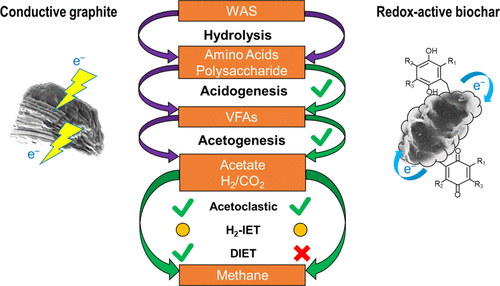当前位置:
X-MOL 学术
›
ACS Sustain. Chem. Eng.
›
论文详情
Our official English website, www.x-mol.net, welcomes your feedback! (Note: you will need to create a separate account there.)
Redox-Active Biochar and Conductive Graphite Stimulate Methanogenic Metabolism in Anaerobic Digestion of Waste-Activated Sludge: Beyond Direct Interspecies Electron Transfer
ACS Sustainable Chemistry & Engineering ( IF 8.4 ) Pub Date : 2020-08-05 , DOI: 10.1021/acssuschemeng.0c04109 Chengxin Lü 1 , Yanwen Shen 1, 2 , Chao Li 2 , Nanwen Zhu 1, 3 , Haiping Yuan 1
ACS Sustainable Chemistry & Engineering ( IF 8.4 ) Pub Date : 2020-08-05 , DOI: 10.1021/acssuschemeng.0c04109 Chengxin Lü 1 , Yanwen Shen 1, 2 , Chao Li 2 , Nanwen Zhu 1, 3 , Haiping Yuan 1
Affiliation

|
Graphite and pyrolytic biochar are two electrically active but functionally distinct carbon materials that have been widely used to enhance methanogenic performance of anaerobic digestion (AD) of waste-activated sludge (WAS) for energy recovery. However, their stimulatory mechanism is not well understood. In this study, adding conductive graphite and corn stover biochar with high electron-donating capacity (EDC) remarkably boosted the methane produced from WAS by 38.3 and 46.9%, respectively. By investigating the role of graphite and biochar addition in AD of WAS during different stages (hydrolysis, acidogenesis, and methanogenesis), we intended to elucidate the complicated mechanism for the improved methane production. The biochar mildly improved hydrolysis and acidogenesis, while the graphite did not. During methanogenesis, both graphite and biochar increased methane production primarily by enhancing the acetoclastic pathway, while syntrophic acetate oxidation via direct interspecies electron transfer (DIET) was not thermodynamically favorable. In the CO2-reducing pathway, biochar was superior to graphite, mainly relying on the redox cycling of functional groups to deliver electrons for Methanosaeta. However, graphite outperformed biochar by 42.4% in terms of methane production under high H2 partial pressure by facilitating DIET. Collectively, redox-active pyrolytic biochar would benefit the WAS methanogenic process, while graphite could be supplemented in high-rate AD systems, representing two economically feasible carbon additives to enhance AD performance under varied operational conditions.
中文翻译:

氧化还原活性生物炭和导电石墨在废物活化污泥的厌氧消化中刺激产甲烷代谢:超越直接种间电子转移。
石墨和热解生物炭是两种具有电活性但功能不同的碳材料,已被广泛用于增强废物活化污泥(WAS)的厌氧消化(AD)的产甲烷性能,以回收能量。但是,它们的刺激机制尚不完全清楚。在这项研究中,添加具有高电子给体能力(EDC)的导电石墨和玉米秸秆生物炭分别将WAS产生的甲烷分别提高了38.3%和46.9%。通过研究石墨和生物炭添加在WAS的不同阶段(水解,酸生成和甲烷生成)中的作用,我们打算阐明提高甲烷产量的复杂机制。生物炭温和地改善了水解和酸生成,而石墨则没有。在产甲烷过程中 石墨和生物炭两者均主要通过增强乙酰碎裂途径来增加甲烷的产生,而通过直接种间电子转移(DIET)产生的共生乙酸盐氧化在热力学上不利。在CO中2 -还原途径中,生物炭优于石墨,主要依靠官能团的氧化还原循环,提供电子对Methanosaeta。但是,通过促进DIET,在高H 2分压下,就甲烷生成量而言,石墨的性能优于生物炭42.4%。总的来说,氧化还原活性的热解生物炭将有益于WAS的产甲烷过程,而石墨可以在高速率的AD系统中进行补充,代表了两种经济可行的碳添加剂,可在不同的操作条件下增强AD的性能。
更新日期:2020-08-24
中文翻译:

氧化还原活性生物炭和导电石墨在废物活化污泥的厌氧消化中刺激产甲烷代谢:超越直接种间电子转移。
石墨和热解生物炭是两种具有电活性但功能不同的碳材料,已被广泛用于增强废物活化污泥(WAS)的厌氧消化(AD)的产甲烷性能,以回收能量。但是,它们的刺激机制尚不完全清楚。在这项研究中,添加具有高电子给体能力(EDC)的导电石墨和玉米秸秆生物炭分别将WAS产生的甲烷分别提高了38.3%和46.9%。通过研究石墨和生物炭添加在WAS的不同阶段(水解,酸生成和甲烷生成)中的作用,我们打算阐明提高甲烷产量的复杂机制。生物炭温和地改善了水解和酸生成,而石墨则没有。在产甲烷过程中 石墨和生物炭两者均主要通过增强乙酰碎裂途径来增加甲烷的产生,而通过直接种间电子转移(DIET)产生的共生乙酸盐氧化在热力学上不利。在CO中2 -还原途径中,生物炭优于石墨,主要依靠官能团的氧化还原循环,提供电子对Methanosaeta。但是,通过促进DIET,在高H 2分压下,就甲烷生成量而言,石墨的性能优于生物炭42.4%。总的来说,氧化还原活性的热解生物炭将有益于WAS的产甲烷过程,而石墨可以在高速率的AD系统中进行补充,代表了两种经济可行的碳添加剂,可在不同的操作条件下增强AD的性能。



























 京公网安备 11010802027423号
京公网安备 11010802027423号